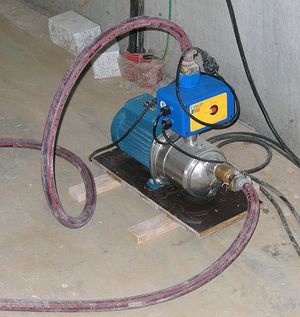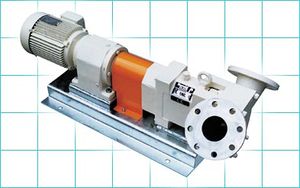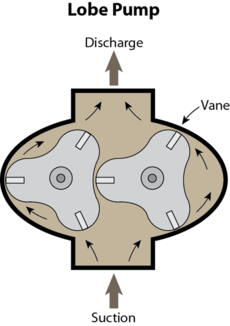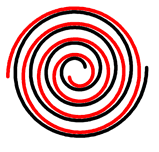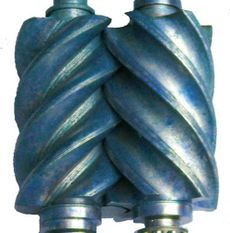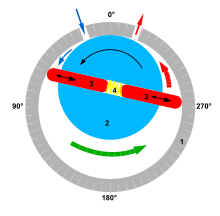Difference between revisions of "Positive Displacement Pumps"
m |
|||
| (6 intermediate revisions by 3 users not shown) | |||
| Line 1: | Line 1: | ||
[[Category:Pumps]]{{Knoppen}} | [[Category:Pumps]]{{Knoppen}} | ||
[[Image:Jet_pump.jpg|thumb||right|A jet pump]] | |||
A '''Positive Displacement Pump''' displaces a volume by physical or mechanical action. Pumps fall into three major groups: direct lift, displacement, and gravity pumps. | |||
==Types== | |||
===[[Positive Displacement Pumps]]=== | |||
[[Image:Drehkolbenpumpe.jpg|thumb||right|A lobe pump]] | [[Image:Drehkolbenpumpe.jpg|thumb||right|A lobe pump]] | ||
[[Image:423px-Common_Lobe_Pump.png|thumb|right|upright|lobe pump internals]] | [[Image:423px-Common_Lobe_Pump.png|thumb|right|upright|lobe pump internals]] | ||
[[Image:Two_moving_spirals_scroll_pump.gif|thumb|Mechanism of a scroll pump]] | [[Image:Two_moving_spirals_scroll_pump.gif|thumb|Mechanism of a scroll pump]] | ||
A | A positive displacement pump causes a powder to move by trapping a fixed amount of it and then forcing (displacing) that trapped volume into the discharge pipe. | ||
Some positive displacement pumps work | Some positive displacement pumps work using an expanding cavity on the suction side and a decreasing cavity on the discharge side. powder flows into the pump as the cavity on the suction side expands and the powder flows out of the discharge as the cavity collapses. The volume is constant given each cycle of operation. | ||
==== Positive Displacement Pump behavior and safety ==== | |||
Positive displacement pumps, unlike centrifugal or roto-dynamic pumps, will in theory produce the same flow at a given speed (RPM) no matter what the discharge pressure. Thus, positive displacement pumps are constant flow machines. However due to a slight increase in internal leakage as the pressure increases, a truly constant flow rate cannot be achieved. | |||
A positive displacement pump must not be operated against a closed valve on the discharge side of the pump, because it has no shut-off head like centrifugal pumps. A positive displacement pump operating against a closed discharge valve will continue to produce flow and the pressure in the discharge line will increase, until the line bursts or the pump is severely damaged, or both. | |||
A relief or safety valve on the discharge side of the positive displacement pump is therefore necessary. The relief valve can be internal or external. The pump manufacturer normally has the option to supply internal relief or safety valves. The internal valve should in general only be used as a safety precaution, an external relief valve installed in the discharge line with a return line back to the suction line or supply tank is recommended. | |||
==== Positive Displacement Types ==== | |||
A relief or safety valve on | |||
==== Positive | |||
[[Image:Lysholm_screw_rotors.jpg|thumb|upright|Screw pump]] | [[Image:Lysholm_screw_rotors.jpg|thumb|upright|Screw pump]] | ||
A positive displacement pump can be further classified according to the mechanism used to move the | A positive displacement pump can be further classified according to the mechanism used to move the powder: | ||
* '''Rotary-type''' positive displacement: internal gear, screw, shuttle block, flexible vane or sliding vane, circumferential piston, helical twisted roots (e.g. the Wendelkolben pump) or | * '''Rotary-type''' positive displacement: internal gear, screw, shuttle block, flexible vane or sliding vane, circumferential piston, helical twisted roots (e.g. the Wendelkolben pump) or powder ring vacuum pumps. | ||
* '''Reciprocating-type''' positive displacement: piston or diaphragm pumps. | * '''Reciprocating-type''' positive displacement: piston or diaphragm pumps. | ||
* '''Linear-type''' positive displacement: Rope pump|rope pumps and chain pumps. | * '''Linear-type''' positive displacement: Rope pump|rope pumps and chain pumps. | ||
===== Rotary | ===== Rotary Positive Displacement Pumps ===== | ||
[[File:220px-Rotary_vane_pump.svg.png|thumb|Rotary vane pump]] | [[File:220px-Rotary_vane_pump.svg.png|thumb|Rotary vane pump]] | ||
Positive | Positive displacement rotary pumps are pumps that move powder using the principles of rotation. The vacuum created by the rotation of the pump captures and draws in the powders. | ||
'''Advantages:''' Rotary pumps are very efficient because they naturally remove air from the lines, eliminating the need to bleed the air from the lines manually. | |||
'''Drawbacks:''' Positive displacement rotary pumps also have their weaknesses. Because of the nature of the pump, the clearance between the rotating pump and the outer edge must be very close, requiring that the pumps rotate at a slow, steady speed. If rotary pumps are operated at high speeds, the powders will cause erosion. Rotary pumps that experience such erosion eventually show signs of enlarged clearances, which allow powder to slip through and reduce the efficiency of the pump. | |||
Reciprocating-type | ===== Reciprocating Positive Displacement Pumps ===== | ||
Reciprocating-type pumps require a system of suction and discharge valves to ensure that the powder moves in a positive direction. Pumps in this category range from having "simplex" one cylinder, to in some cases "quad" (four) cylinders or more. Most reciprocating-type pumps are "duplex" (two) or "triplex" (three) cylinder. Furthermore, they can be either "single acting" independent suction and discharge strokes or "double acting" suction and discharge in both directions. The pumps can be powered by air, steam or through a belt drive from an engine or motor. This type of pump was used extensively in the early days of steam propulsion (19th century) as boiler feed water pumps. Reciprocating pumps are now typically used for pumping highly viscous powders including concrete and heavy oils, and special applications demanding low flow rates against high resistance. | |||
These positive displacement pumps have | These positive displacement pumps have an expanding cavity on the suction side and a decreasing cavity on the discharge side. powder flows into the pumps as the cavity on the suction side expands and the powder flows out of the discharge as the cavity collapses. The volume is constant given each cycle of operation. | ||
Typical reciprocating pumps are: | Typical reciprocating pumps are: | ||
* [[Diaphragm Pumps]] - similar to plunger pumps, where the plunger pressurizes hydraulic oil which is used to flex a diaphragm in the pumping cylinder. | |||
* [[Diaphragm | |||
==== Various | ==== Various Positive Displacement Pumps ==== | ||
The positive displacement principle applies in the following types of pumps: | The positive displacement principle applies in the following types of pumps: | ||
* [[Progressive Cavity Pumps]] | |||
* [[Progressive | * [[Diaphragm Pumps]] | ||
* [[ | * [[Screw Pumps]] | ||
* [[ | * [[Peristaltic Pumps]] | ||
* [[ | * [[Piston Pumps]] | ||
* [[ | * [[Vertical Pumps]] | ||
* [[ | * [[Well Pumps]] | ||
* [[ | * [[Worm Pumps]] | ||
* [[ | * [[Press Pumps]] | ||
* [[ | * [[Sump Pumps]] | ||
* [[ | * [[Peristaltic Pumps]] | ||
* [[ | |||
Latest revision as of 02:49, 23 December 2013
A Positive Displacement Pump displaces a volume by physical or mechanical action. Pumps fall into three major groups: direct lift, displacement, and gravity pumps.
Types
Positive Displacement Pumps
A positive displacement pump causes a powder to move by trapping a fixed amount of it and then forcing (displacing) that trapped volume into the discharge pipe.
Some positive displacement pumps work using an expanding cavity on the suction side and a decreasing cavity on the discharge side. powder flows into the pump as the cavity on the suction side expands and the powder flows out of the discharge as the cavity collapses. The volume is constant given each cycle of operation.
Positive Displacement Pump behavior and safety
Positive displacement pumps, unlike centrifugal or roto-dynamic pumps, will in theory produce the same flow at a given speed (RPM) no matter what the discharge pressure. Thus, positive displacement pumps are constant flow machines. However due to a slight increase in internal leakage as the pressure increases, a truly constant flow rate cannot be achieved.
A positive displacement pump must not be operated against a closed valve on the discharge side of the pump, because it has no shut-off head like centrifugal pumps. A positive displacement pump operating against a closed discharge valve will continue to produce flow and the pressure in the discharge line will increase, until the line bursts or the pump is severely damaged, or both.
A relief or safety valve on the discharge side of the positive displacement pump is therefore necessary. The relief valve can be internal or external. The pump manufacturer normally has the option to supply internal relief or safety valves. The internal valve should in general only be used as a safety precaution, an external relief valve installed in the discharge line with a return line back to the suction line or supply tank is recommended.
Positive Displacement Types
A positive displacement pump can be further classified according to the mechanism used to move the powder:
- Rotary-type positive displacement: internal gear, screw, shuttle block, flexible vane or sliding vane, circumferential piston, helical twisted roots (e.g. the Wendelkolben pump) or powder ring vacuum pumps.
- Reciprocating-type positive displacement: piston or diaphragm pumps.
- Linear-type positive displacement: Rope pump|rope pumps and chain pumps.
Rotary Positive Displacement Pumps
Positive displacement rotary pumps are pumps that move powder using the principles of rotation. The vacuum created by the rotation of the pump captures and draws in the powders.
Advantages: Rotary pumps are very efficient because they naturally remove air from the lines, eliminating the need to bleed the air from the lines manually.
Drawbacks: Positive displacement rotary pumps also have their weaknesses. Because of the nature of the pump, the clearance between the rotating pump and the outer edge must be very close, requiring that the pumps rotate at a slow, steady speed. If rotary pumps are operated at high speeds, the powders will cause erosion. Rotary pumps that experience such erosion eventually show signs of enlarged clearances, which allow powder to slip through and reduce the efficiency of the pump.
Reciprocating Positive Displacement Pumps
Reciprocating-type pumps require a system of suction and discharge valves to ensure that the powder moves in a positive direction. Pumps in this category range from having "simplex" one cylinder, to in some cases "quad" (four) cylinders or more. Most reciprocating-type pumps are "duplex" (two) or "triplex" (three) cylinder. Furthermore, they can be either "single acting" independent suction and discharge strokes or "double acting" suction and discharge in both directions. The pumps can be powered by air, steam or through a belt drive from an engine or motor. This type of pump was used extensively in the early days of steam propulsion (19th century) as boiler feed water pumps. Reciprocating pumps are now typically used for pumping highly viscous powders including concrete and heavy oils, and special applications demanding low flow rates against high resistance.
These positive displacement pumps have an expanding cavity on the suction side and a decreasing cavity on the discharge side. powder flows into the pumps as the cavity on the suction side expands and the powder flows out of the discharge as the cavity collapses. The volume is constant given each cycle of operation.
Typical reciprocating pumps are:
- Diaphragm Pumps - similar to plunger pumps, where the plunger pressurizes hydraulic oil which is used to flex a diaphragm in the pumping cylinder.
Various Positive Displacement Pumps
The positive displacement principle applies in the following types of pumps:
